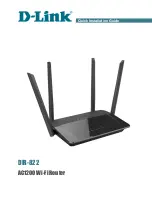
Hardware Installation and Reference Guide
Preparing for Installation
8
2.4
Installation Environment Requirements
The RG-EG105GW(T) router must be used indoors. To ensure normal operation and prolong the service life of
the device, the installation site must meet the following requirements.
2.4.1
Installation Requirements
Install the device into an open environment. If the device is installed into a closed environment, ensure that
the cabinet has proper ventilation and heat dissipation.
Make sure that the installation site is sturdy enough to bear the weight of the device and its accessories.
You are advised to install the device on a standard workbench and maintain a proper clearance around the
air vents for heat dissipation.
2.4.2
Ventilation Requirements
The RG-EG105GW(T) router adopts natural cooling. Reserve sufficient space around the device to ensure
normal heat dissipation.
2.4.3
Temperature and Humidity Requirements
To ensure the normal operation and prolonged service life of the device, maintain an appropriate temperature
and humidity in the equipment room. The equipment room with too high or too low temperature and humidity for
a long period may damage the device.
In an environment with high humidity, the insulating material may have poor insulation or even leak electricity.
Sometimes it is also prone to changes in the mechanical properties and causes rusting of metal parts.
In an environment with low relative humidity, static electricity is prone to occur and damage the internal
circuits of the device.
Too high temperatures can accelerate the aging of insulation materials, greatly reducing the reliability of the
device and severely affecting its service life.
Table 2-1
Temperature and Humidity Requirements
Operating Temperature
Operating Humidity
0ºC to 40ºC (32ºF to 104ºF)
5% to 95% RH (non-condensing)
2.4.4
Cleanliness Requirements
Dust poses a major threat to the device. The indoor dust takes on a positive or negative static electric charge
when falling on the device, causing poor contact of the metallic joint. Such electrostatic adhesion may occur
more easily when the relative humidity is low, not only affecting the service life of the device, but also causing
communication faults. The following table describes the requirements for the dust content and granularity in the
equipment room.
Table 2-2
Requirements for Dust
Max Diameter of
Dust Particle (μm)
0.5
1
3
5
Max Content (Particles/m
3
)
1.4×10
7
7×10
5
2.4×10
5
1.3×10
5
















































